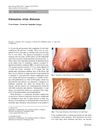Search
for
Sort by
Research
30 / 1000+ results
research General Theory of Skin Reinforcement
Skin and its underlying fat layer act together to resist mechanical stress, and reinforcing this composite structure may help more with anti-aging than just strengthening the skin alone.
research The Susceptibility of Disulfide Bonds to Modification in Keratin Fibers Undergoing Tensile Stress
Disulfide bonds in keratin fibers break more easily under stress, especially when wet, affecting fiber strength.

research Mechanical Forces of Human Dermal Fibroblasts Significantly Decrease with Age
Skin cell strength decreases significantly as we age.
research Study of the Structural-Mechanical Properties of Cream with Minoxidil
The 2% minoxidil cream is stable, spreads well on the skin, and helps with hair growth.

research Lamins in Development, Tissue Maintenance, and Stress
Lamins are vital for cell survival, organ development, and preventing premature aging.
research Understanding Breakage in Curly Hair
Curly hair breaks due to mechanical damage and environmental factors, not chemical makeup, and needs ongoing care to prevent breakage.

research Deciphering Principles of Morphogenesis from Temporal and Spatial Patterns on the Integument
The conclusion is that skin and hair patterns are formed by a mix of cell activities, molecular signals, and environmental factors.

research Trichorrhexis Nodosa After Hair Transplantation: Dermoscopic, Pathologic and Electron Microscopy Analyses
Hair transplant complications were likely due to deep graft placement and rough handling.

research Novel Shampoo Reduces Hair Shedding by Contracting the Arrector Pili Muscle via the Trace Amine-Associated Receptor
New shampoo with tyramine hydrochloride reduces hair loss by making a small muscle in the hair follicle contract.

research Update on Hidradenitis Suppurativa (Part I): Epidemiology, Pathogenesis, Severity Assessment and Comorbidities
Hidradenitis suppurativa is a chronic skin condition more common in women, linked to genetics and lifestyle factors, and associated with various other health issues.

research In-Situ Tensile Testing of Hair Fibers in an Environmental Scanning Electron Microscope
Hair fibers break by cuticle cell slipping, shape changing, cuticle fraying, and surface cracking when stretched under specific conditions.
research In Situ Tensile Deformation Characterization of Human Hair with Atomic Force Microscopy
AFM helped show how hair changes under tension and the effects of damage and conditioner.

research Chapter 4: Cytomechanics of Hair
Hair's strength and flexibility come from its protein structure and molecular interactions.

research Development and Homeostasis of the Skin Epidermis
The skin protects the body and is constantly renewed by stem cells; disruptions can lead to cancer.
research Molecular Genetics of Inherited Disorders of Epidermal Keratins
Mutations in keratin genes cause skin disorders, but new treatments show promise.

research Biomechanical Properties of Scalp Flaps and Their Correlations to Reconstructive and Aesthetic Surgery Procedures
Scalp flaps are stiffer than skin from other body areas, which helps in planning reconstructive and cosmetic head surgeries.
research Trichorrhexis Nodosa: Study on Hair Involvement and Trauma
Trichorrhexis nodosa is mainly caused by hair trauma and improves with gentler hair care.

research Edematous Striae Distensae in a 14-Year-Old Girl with Nephrotic Syndrome
The girl's swelling and skin issues improved with fluid restriction and diuretics.

research 702 dsRNA Induces Ectopic KRT9 Expression via WNT/β-Catenin-Mediated Signaling
Double-stranded RNA activates a pathway that causes a skin protein to be expressed in the wrong place.

research Toward Understanding Scarless Skin Wound Healing and Pathological Scarring
Scarless healing is complex and influenced by genetics and environment, while better understanding could improve scar treatment.

research Scarless Wound Healing: Transitioning from Fetal Research to Regenerative Healing
Understanding how baby skin heals without scars could help develop treatments for adults to heal wounds without leaving scars.

research Mechanical Forces in Skin Disorders
Skin problems can be caused or worsened by physical forces and pressure on the skin.

research Skin Aging as a Mechanical Phenomenon: The Main Weak Links
Skin aging is largely due to differences in stiffness and elasticity between skin layers, leading to wrinkles.

research Endoplasmic Reticulum Stress at the Crossroads of Progeria and Atherosclerosis
A defective protein in progeria causes cell death and atherosclerosis, but a treatment targeting cell stress may reduce these effects.

research Hair Resistance to Mechanical Wear
Hair's resistance to wear varies by ethnicity and treatment, with less wear indicating stronger hair.

research Mechanical Forces Across Compartments Coordinate Cell Shape and Fate Transitions to Generate Tissue Architecture
Mechanical forces are crucial for shaping cells and forming tissues during development.

research Mechanical Stretch Upregulates SDF-1α in Skin Tissue and Induces Migration of Circulating Bone Marrow-Derived Stem Cells into the Expanded Skin
Stretching skin increases a certain protein that attracts stem cells, helping skin regeneration.

research Adult Skin Acute Stress Responses to Short-Term Environmental and Internal Aggression from Exposome Factors
Adult skin quickly reacts to short-term environmental and internal stress, leading to various skin issues and the need for protective measures.

research Systems Approach to Human Hair Fibers: Interdependence Between Physical, Mechanical, Biochemical, and Geometric Properties of Natural Healthy Hair
Hair properties are interconnected; a comprehensive, cross-disciplinary approach is essential for understanding hair behavior.